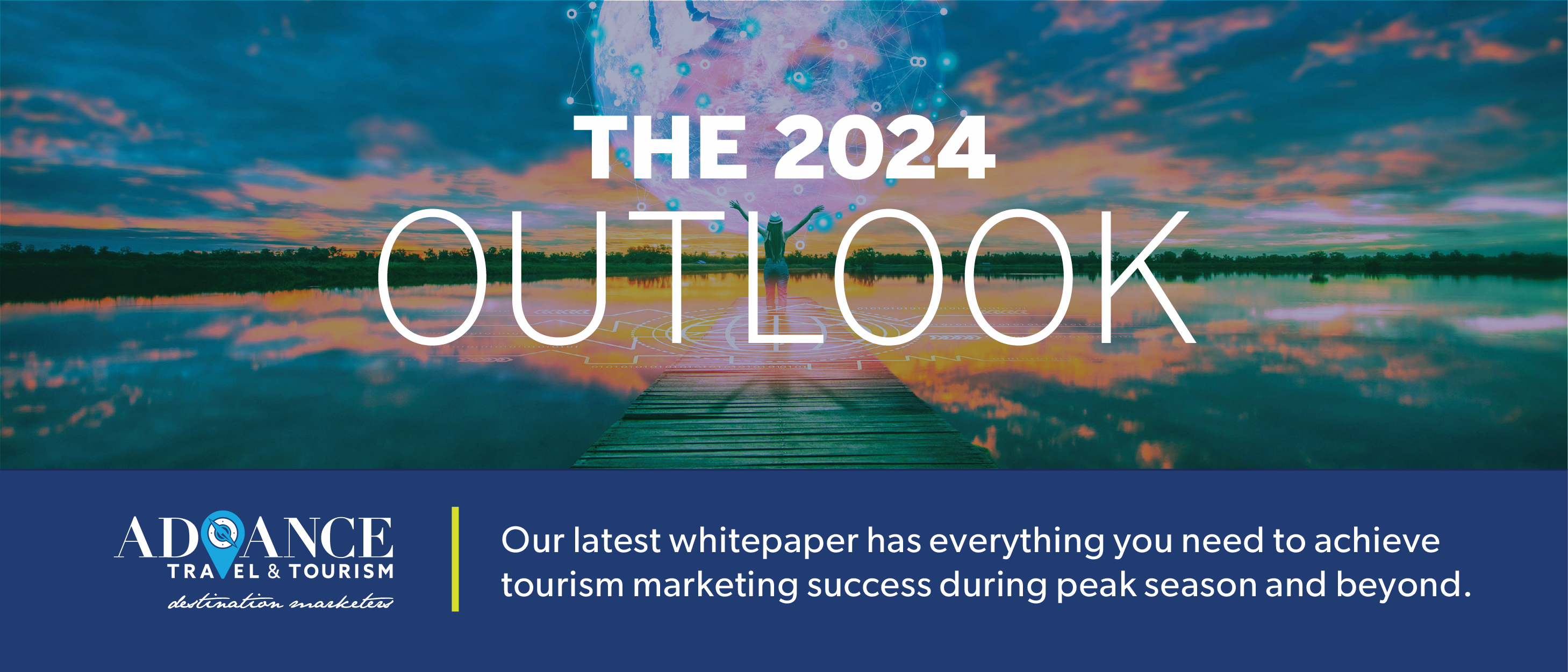What tourism organizations should know about GA4
On Friday, October 21, we presented a webinar in partnership with Southeast Tourism Society with introductory information to GA4 for tourism organizations. Thank you to all of those who attended the webinar. It was a fun, interactive session with essential information on how to move forward with the new and improved website analytics platform.
We have created this corresponding blog for you to have a condensed takeaway to share with your team, your board, or your stakeholders.
Let’s quickly begin with the why behind Google’s plans for GA4.
As you know, the way we use the internet has evolved significantly over the years, whether we are using different devices to view the same content, watching videos, or quickly clicking to find the information we are looking for. Universal Analytics was primarily created to measure users to a website, or hits. While GA4 is created to monitor user behavior more effectively; GA4 understands that there’s a lot more happening on your website than pages being loaded in a particular order.
There is also a push in the industry for more opt-in data from users, and with the evolution of data walls for content, GA4 is set to handle the new flow of information. You should begin thinking of analytics as less of a reporting tool and more of an analysis engine. The goal of your reporting should be to understand how users interact with your website; NOT how many users came to your website. Understanding this is essential to understanding the new key metrics from GA4.
Now that you know the why behind the shift, we can briefly discuss the how behind how GA4 will begin to monitor user behavior on your site and other platforms.
With privacy changes across the industry, and the desire to have more opt-in data collection from users, you now have to think of analytics data collection similar to how you think of surveys. We now just need a sample size of data to better understand behavior on our site. You may have done a research study in the past where you sent out emails or had someone on the ground asking visitors questions about your community—not everyone will respond, but you do collect enough information to make strategic decisions moving forward. This is the simplest way to describe how GA4 will be analyzing and showcasing user behavior on your website.
So, what are the new metrics you should be aware of from the beginning? Here are a few of the major changes that may be most important for tourism organizations.
| Universal Analytics | GA4 | Definition in GA4 |
| Users
New Users |
Users
New Users Active Users |
Same
Same Number of users that have been active within a 28 day time period. |
| Page Views | Views | No change except the name. |
| Unique Pageview | N/A | This metric will not be included in GA4. |
| Goals | Conversions | No change except the name and types. |
| Bounces/Bounce Rate
(deprecated) |
Engaged sessions | An engaged session is a session that either last more than 10 seconds, a user visited more than one page, or a conversion takes place. |
| Universal Analytics | GA4 | Definition in GA4 |
| Pages per Session (deprecated) | Engaged Sessions per User | The number of engaged sessions triggered by a user. |
| —————— | Percentage of Engaged Sessions | Percentage of sessions that resulted in an Engaged Session |
| Average Session Duration | Average Engagement Time | The average length of time the web page was in view. |
| Metro | N/A | This will not exist in GA4 |
| Events | Event Name/Event Count | New Default and Custom types |
You’ll notice very quickly some of the new buzzwords from GA4—Engagements, Engaged Sessions, and Average Engagement Time. These are key metrics that are entirely new in the way they are calculated and the way we should view them. You can’t compare these metrics to previous metrics like Average Session Duration. We will all be learning what the benchmarks for these metrics are over the next several months. What we can see is that higher engagement rates do tend to happen from Organic traffic and Paid Search, and lower engagement rates from Display or Social. This seems to be on par with where a potential traveler is in their travel planning journey.
Many tourism organizations use what we call soft conversions on their site—like a pageview to the ticketing page, or a pageview to a lodging page. These will now change to events in GA4. True conversions will be from form fills, ticket purchases, or outbound referrals. Many engagement events will be default set up when launching GA4, while other more specific ones (like listed above) will need to be manually created.
With all of these changes, you can expect to stop reporting on Average Time on Page, Session Duration, Bounce Rate, and more. Your conversion rates will also shift significantly. For example, if you have soft conversions for pageviews, you likely have a high overall goal conversion rate (<20%), while form fills drive a much lower conversion rate (>5%). The conversion rate for your site will decline once you make the shift. This is not a bad thing! This is a better understanding of user behaviors and differentiating users with strong interest in your brand.
The final major shift in UA to GA4 that your organization should be aware of are the new default channel groupings. In the current UA set up, there are 7 default channel groupings—organic, direct, display, social, paid search, referral, email. In GA4 there are dozens of channel groupings, including organic social, organic video, paid video, and more. Because of this, when you make the full switch to GA4, you or your marketing team will need to adjust your UTMs for digital campaigns to follow accordingly.
Now that you have watched our webinar and read this article, you may be asking yourself “What do I do now?”
- Start by launching your GA4.
- You will want to have as much data as possible before UA is sunset as early as July of 2023.
- Share this article with your team members, board, and stakeholders as you transition them to new data points of reporting.
- Remember, this is an ever-changing environment, so keep yourself and your team in the loop on updates moving forward.
- Prepare yourself for a go-live date once you and your team are well acquainted with GA4.
- You can start to use GA4 for analysis now without making the full switch.
If you or your team have any questions about GA4 or the future of monitoring your marketing campaigns, feel free to reach out to any of our team members at Advance Travel and Tourism. We know there are many other platforms these days to better understand travelers, but your ‘store front’ is still an incredibly valuable asset to understand user behavior with your brand and ultimately make smart and innovative marketing decisions. We can help navigate that in collaboration with you.
References:
https://support.google.com/analytics/answer/9756891?hl=en
https://support.google.com/analytics/answer/9322688?hl=en
https://support.google.com/analytics/answer/11986666?hl=en#zippy=%2Cin-this-article
https://support.google.com/analytics/answer/9216061?hl=en
https://support.google.com/analytics/answer/10089681?hl=en
https://www.socialmediaexaminer.com/google-analytics-4-migration-how-to-prepare/
If you’d like to learn more about how we can help you adapt to the evolving marketing landscape and ramp up your efforts, please contact us today.
Share This Story, Choose Your Platform!
April 2, 2024

The 2024 Travel Outlook Survey Results are Here
Even with sophisticated data and consumer profiling, success relies on the basics — that is, the right time, right place, right message directed at the right audience. When you’re thinking about how you can best reach travelers and potential travelers as they move across their digital journey, these four considerations are the key to success. Sounds simple enough? Yes and no. [...]
February 22, 2024

Is Your Destination a Memorable Masterpiece?
One thing I have turned to over the last several years is LEGO and truly getting into enjoying the hours it takes to build something. It really is about the memories created brick by brick, and this got me thinking… As Destination Marketers, we are not too far off from being a LEGO Designer. It just looks a [...]
February 2, 2024

A Digital Marketer’s Survival Guide for This Election Year
Every year, digital marketing presents unique challenges and trends, but an election year takes the complexity to a whole new level. As the political landscape transforms, the effects ripple across various sectors, including digital advertising. […]
CONTACT US TODAY TO DISCUSS YOUR NEW TOURISM MARKETING STRATEGY
"*" indicates required fields
